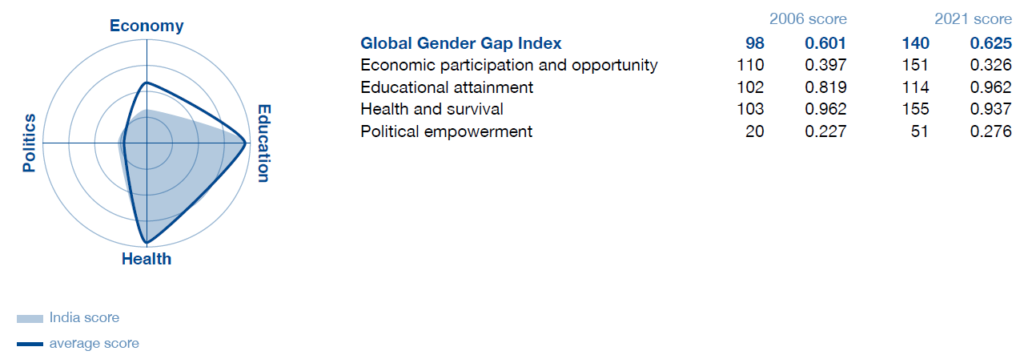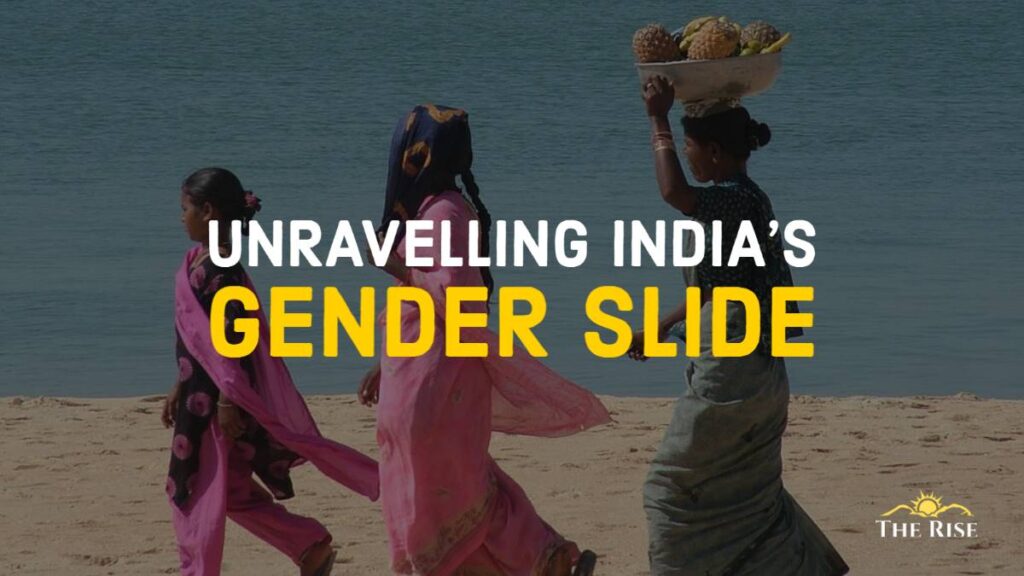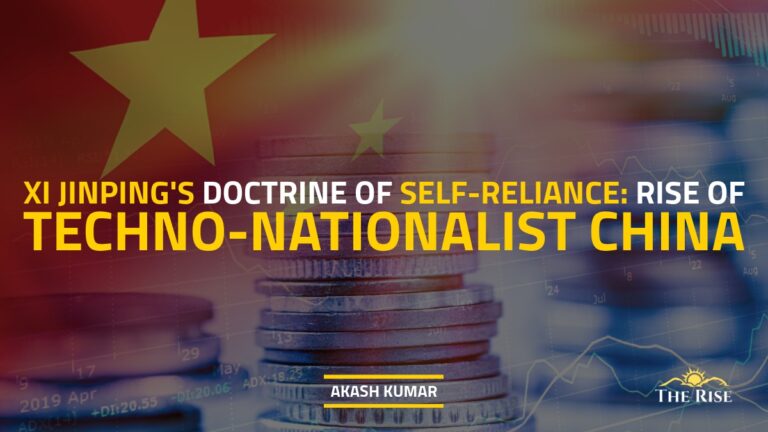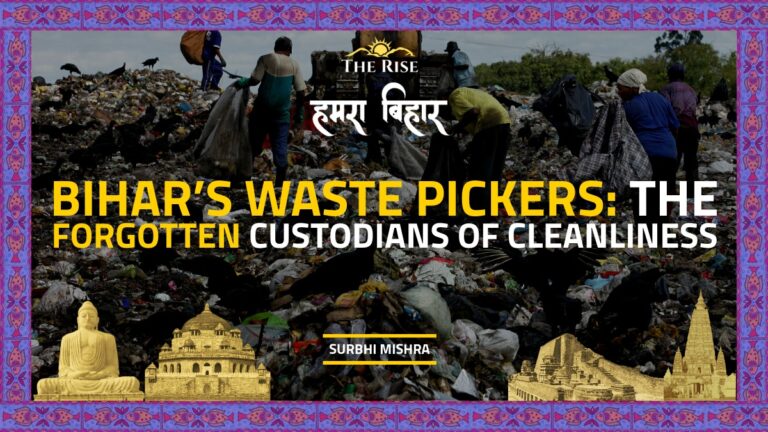There are ample instances of the country’s governance striving to bring equity between men and women, but the gaps in the desired outcomes are evident from the falling index values, meaning that the majority of efforts for bringing in parity are getting consumed only in documents.
It is raining cats and dogs when it comes to India’s rankings in various global indices. The year 2021 has witnessed India slipping down from ‘free’ to ‘partly free’ status as per the “Freedom in the World 2021” report by Freedom House. Yet another saddening report came from Swedish Institute V-Dem which flagged India as an endangered democracy due to the severely shrinking of space for the media, civil society, and the opposition.
Now, the recent report on “Gender Gap Index 2021” has delineated India at 140th rank with a score of 0.625 on the scale of 0 – 1 among 156 nations studied by the World Economic Forum of Switzerland. As per the WEF report, Iceland is privileged to have the least Gender Gap score of 0.892 on the scale of 0 – 1 with 1st rank in the year 2021. The worst country, when it comes to gender parity, is Afghanistan with a Gender Gap score of 0.444 and an unenviable rank of 156/156. India is reported to have slipped down by 28 ranks due to its score reducing by 0.0424 as compared to the year 2020.
Among the South Asian countries, Bangladesh has the best Gender Gap Index Score of 0.719 and a global rank of 65 followed by Nepal with a score of 0.683 and rank of 106, Sri Lanka with a score of 0.670 and rank of 116, the Maldives with a score of 0.642 and rank of 128, Bhutan with a score of 0.639 and rank of 130, India with a score of 0.625 and rank of 140, Pakistan with a score of 0.556 and rank of 153, and the last is Afghanistan with a score of 0.444 and rank of 156.

May Read: Is There a Future for Feminism?
Undoubtedly, the year 2020 has been cursed by the COVID-19 pandemic that impacted all sectors and disrupted the economic activities due to lockdowns. All economies of the world have suffered adversely, but the developing economies have been the most affected ones. The confinement of people in homes and burdening of healthcare & frontline workers has affected the men and women both. But, the larger brunt has come upon the women contributing in different sectors – both as frontline soldiers against the pandemic as well as homemakers. The ongoing initiatives for inclusive and prosperous economies with gender parity got thwarted. Thence, the recovery of economic and other activities essentially requires the restoration of gender equity as that of pre-COVID times.
Parameters accounted for by WEF
The gender gap in different countries is assessed by the World Economic Forum through the Global Gender Gap Index. This index monitors the forthcoming minimization of the gender gap in future and benchmarks the evolution of gender-based gaps based on:
- Economic Participation and Opportunity,
- Educational Attainment,
- Health and Survival, and
- Political Empowerment.
May Read: Introspecting the COVID-19 Lockdown in India
Economic Participation and Opportunity
The estimation of scores in this parameter is based on ‘labour force participation rate’, ‘wage equality for similar work’, ‘estimated earning income’, ‘legislators, senior officials and managers’, and ‘professional and technical workers’. India ranks a deplorable 151 while Afghanistan is the lowest at 156 ranks in female’s economic participation and opportunity parameter.
It is saddening to find the pandemic and the hastily declared nationwide lockdown in 2020 accelerated the decline of already poor economic participation of women. Women’s labour force participation rate and the share of women in technical roles has declined in 2020, reducing the estimated earned income of women, which is one-fifth that of men. An average Indian woman earns 20.7% lesser compared to an average Indian man.
Educational Attainment
The educational attainment is quantified based on ‘literacy rate’, ‘enrolment in primary education’, ‘enrolment in secondary education’, and ‘enrolment in tertiary education’. In the educational attainment parameter, Argentina is on the top and India at 114 ranks while Afghanistan is at the bottom with 156 rank.
The lower enrolment ratio, and high dropout rates for girls as compared to boys need to be addressed with special focus in Indian policy. India also needs to focus on better implementation of its flagship scheme of ‘Beti Bachao, Beti Padhao’.
Health and Survival
The health and survival is assessed on the basis of ‘sex ratio at birth’, and ‘health life expectancy’. The Bahamas has the 1st rank with the best score in health and survival parameter, while India is at 155 rank and China is at the bottom with 156 rank. In South Asian region, Sri Lanka has the best situation with 30 rank, Nepal at 113, Bhutan at 131 rank, , Bangladesh at 134, Maldives at 148 rank, Afghanistan is at 149 rank, and Pakistan at 153 rank.
According to the Report, wide sex ratio at birth gaps due to high incidence of genderbased sex-selective practices has contributed to India being in the bottom five countries in this parameter. India’s poor health infrastructure and its even poor accessibility for women have added to its disreputable rank.
Political empowerment
The assessment of political empowerment for its inclusion in the overall gender parity index is done based on the ‘women in parliament’, and ‘women in ministerial positions’, and ‘years of female as head of state’. India’s 28 rank slip in 2021 Gender Gap Index can be mainly attributed to the steep decline in this subindex compared to previous year. India gets the 51st rank, while Iceland tops with Ist rank and Vanuatu with the last rank of 156.
According to the report, the main change that took place this year is the significant decline in the share of women among ministers, which halved, from 23.1% in 2019 to 9.1% in 2021. In addition, the share of women in parliament remains stagnant at 14.4% and the share of the last 50 years in which a woman has been head of state is 15.5.
The saddening situation gets aggravated further when the top officials and ministers look down to women in politics. It is, hence, not surprising to know that India now has just one sitting women Chief Minister – Mamata Banerjee. The sheer decline in top women leadership across the country, with a vacuum in most of the large political parties justifies India’s rank in this subindex.
May Read: A Spine-Chilling Moment for India: Will Hathras become an eye-opener?
Although the parameters for arriving at the overall score appear to be assessed discretely, the indirect mutual inclusiveness and dependency of one on the other can not be ruled out. The well-being of females on any account is likely to make commensurate amelioration on the other attributes too and thus overall good of society.
Unequivocally, the gender parity got severely jolted due to COVID and needs revitalization in the post-COVID-19 times. Every nation has its own strategy for accomplishing a better state of affairs. Some of the generic initiatives proposed in the report for gender-neutral recoveries are;
- Reskilling women to be ready for reemployment in a high-growth sector
- Gender-sensitive workforce planning and redeployment policies and strategies
- Close gender gaps in remuneration between and within sectors through pay reviews and appropriate remediation policies, & improving work quality and pay standards across currently low-paid essential work
- Enable women’s participation in the labour force through flexible/alternative work arrangements that support diverse workforces, & enhancing social safety nets, specifically on the provision of childcare support
- Advance more women into management and leadership through setting targets for women in leadership on a Government and business level
Schemes like direct cash transfer of ₹500 to women’s accounts, Ujjwala Scheme, One Stop Centre Scheme, and Sukanya Samriddhi are steps in the right direction. But, there implementation remains abominable.
The scores and ranking of countries are not mere numbers, rather these stimulate every nation across the world to thrive to ensure gender parity and builds a sustainable healthy society. Every nation has to look into each of these dimensions and strategize for equating men and women. Lately, it is being observed that a major section of society tend to discredit such rankings as ‘international conspiracies‘ to tarnish India’s image. However, such complacency and arrogance need to be replaced by self-introspection if we truly want to fight such ‘conspiracies’ and become the ‘vishwaguru’. Rather than retaliating with official bureaucratic counter-statements, these rankings should be viewed as opportunities to know our weaknesses and introspect within, rather than.
India, being the second populous nation of the world with the largest share of young population, has to sincerely introspect to evolve suitable approaches for gender parity. There are ample instances of the country’s governance striving to bring equity between men and women, but the gaps in the desired outcomes are evident from the falling index values, meaning that the majority of efforts for bringing in parity are getting consumed only in documents. Therefore, concerted efforts are required for changing the mind of regulators and all other stakeholders for achieving the visible parity at ground zero.
We have already lost much of the ‘India 2020’ dream envisioned by Former President Kalam to petty politics and jingoism. Let’s not lose this golden phase of 37-year demographic dividend into which India entered three years ago!
Disclaimer: The views expressed in this article are of the author solely. TheRise.co.in neither endorses nor is responsible for them.
About the author
Sneha Yadav is an electronics engineer with post graduation in political science by qualification. Sneha has wide-ranging interests in the contemporary social, economic, administrative and political issues of India.











Pingback: Abuse and Neglect in Care Homes - TheRise.co.in
Pingback: Investigating Hunger concerns of India - TheRise.co.in